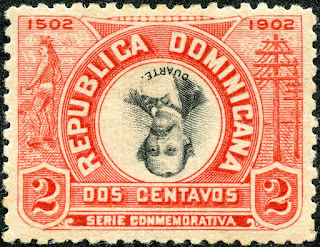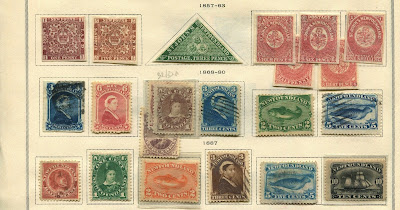1902 Scott 145a 2c scarlet & black
"Juan Pablo Duarte"
Center Inverted
Into the Deep BlueI think many of us collectors harbor the not so secret wish that we might discover a great rarity someday: better still if it is a spectacular "center inverted", such as the upside down "Jenny" (Scott C3a CV $850,000 never hinged).
Well, what if I told you, although a great rarity is probably not in the cards, obtaining inverted specimens from the classical stamp period is not out of the question?
At a local Stamp Club meeting back in 2011, I was offered a complete set of "inverteds" from the engraved bi-color Dominican Republic 1902 Scott "400th anniversary of Santo Domingo" issue. How could I pass it up?
For more on the Dominican Republic proper and their stamps, see...
1902 Scott 144 & 144a 1c dark green & black
"Francisco Sanchez"
"400th Anniversary of Santo Domingo"
Original & Center Inverted
Well, how could an engraved bi-color stamp become "inverted"?
Rather simple. Back in the early classical stamp era, generally a bi-color stamp would require two printing press passes to manufacture the stamp: One for the frame, and one for the center.
If a mistake was made in placing the frame and center correctly, a sheet of "center inverted" stamps might be produced.
Regarding this stamp...
Note the lovely portrait of a sailing vessel under the "1502" date? Then note the more "modern" ship under the "1902" date? Interestingly, the modern ship is still equipped with sails.
Regarding Francisco Sanchez....
Francisco Sanchez was one of the three hero-patriots of the Dominican Independence (from Haiti) movement in 1844. When Duarte was exiled, Sanchez was the voice of the rebellion. The Son of Afro-Dominican parents, he was a man of action, but also taught himself Latin and French. He was exiled by General Santana for four years, but then returned. When he objected to Santana returning the Dominican Republic to Spain as a colony in 1861, he was executed.
1902 Scott 145 & 145a 2c scarlet & black
"Juan Pablo Duarte"
"400th Anniversary of Santo Domingo"
Original & Center Inverted
Well, what did I pay for the six "center inverted" 1902 issue stamps? - $39 or $6.50/stamp. The CV in 2011 for these "center inverted" stamps was $6/stamp (unused). (The CV for 'normal" stamps in the seven stamp set ranged from 25c to 50c.)
If you compare, the price is about 14,000 times less than the 1901 U.S. Pan-American 4c inverted (CV $85,000). !!
The CV price in the 2020 Scott catalogue has risen somewhat: $17.50/stamp - Not much!
Why is this "inverted" so inexpensive? - I can think of three reasons..
a) Example: The Liberia Scott 62a bi-color 1905 5c ultramarine & black "Elephant" "center inverted" stamp has a CV of $1,600 presently. It objectively is as rare as the USA "inverted Jenny" C3a, as both are known with only ONE SHEET of 100 stamps. Yet the USA C3a is 280X- 530X CV more expensive. Clearly, POPULARITY and DEMAND is a large part of price.
b) I greatly suspect there were many sheets of the "inverted center" 1902 Dominican Republic issue available (more on this later). That would clearly drive down price.
c) The third reason is that Scott is undervaluing the CV for these stamps.
The Linn's article (7-5-2019) above, by Henry Gitner & Rick Miler, says there is strong demand for these 'center inverted" stamps, and one could pay at least $30/stamp for them, even in less than very fine grade.
Regarding this stamp...
Note the wonderful period artistry of the stamp with the native portraiture on the left (carrying "mail"!) , and the "modern" poles and wires on the right.

1902 Scott 146 & 146a 5c blue & black
"Juan Pablo Duarte"
"400th Anniversary of Santo Domingo"
Original & Center Inverted
A look at the "center inverted" stamps would suggest they are of the same quality as the originals. This does not look like worn plates being pilfered and "center inverted" variations being produced, or printer waste. Rather, it suggests that the "center inverted" stamps were produced deliberately (My own opinion); or, if produced by production error, the "center inverted" stamps were not destroyed (as the U.S. postal administration would try to do), but obtained by the philatelic trade.
Regarding Duarte...
Duarte is considered the Father of the independence movement from Haiti. The highest mountain in the Dominican Republic (Pico Duarte) is named for him, and there is Juan Pablo Duarte Square along the Avenue of the Americas in New York City.
He was asked to be the first President in 1844, but was exiled by General Pedro Sanatana. Now Santana and his conservative cohorts believed the best way to prevent being absorbed by Haiti was to align the Dominican Republic with Spain's interests. In fact, as mentioned, in 1861 Sanatana returned the Dominican republic to Spain as a colony. Duarte died in exile in Caracas, Venezuela.
1902 Scott 147 10c orange & black
"Francisco Sanchez"
"400th Anniversary of Santo Domingo"
Original (No Center Inverted exists)
Of interest, the 10c orange & black is not known inverted. The other six stamps in the set are known inverted. I'm sure there is a story behind this.

1902 Scott 148 & 148a 2c purple & black
"Ramon Meila"
"400th Anniversary of Santo Domingo"
Original & Center Inverted
I speculated earlier above on the possible origin of the inverted stamps. My own opinion is that the 1902 "center inverted" samples were deliberately produced.
Of interest, the Gibbons Stamp Weekly of Oct 16, 1909, page 377 states:
"There seems to be some doubt as to the status of these six stamps, it being considered by certain people that all of the above errors were the outcome of a "special request". Whether or not these inverted stamps were printed to order I do not profess to know, that being scarcely a point of concern here. The stamps are not rare and can be in the collection of all who desire them."
One can tell from this early comment (1909), two points:
a) It is clear that the origin of these center inverted stamps was not definitively known by the author: otherwise he would have said so. Certainly, the speculation was that shenanigans was involved. It might even be hinted (in the circuitous writing style of the day ), that some people actually did know the "special request" story. It is certainly possible that a Dominican Republic specialist, or a specialist journal might know or reveal more of the story.
b) It was recognized, even at this early time, that the 1902 "center inverted" stamps were easily available and obtained.
Regarding the stamp design...
Note the man with a torch under "1502", and the street lamp under "1902". There is a woman on a pedestal below the street lamp. What does that signify?

1902 Scott 149 & 149a 20c rose & black
"Ramon Meila"
"400th Anniversary of Santo Domingo"
Original & Center Inverted
Regarding "Ramon Melia"...
Ramon Mella was the third patriot of the Independence movement. He was known for "the shot". When the rebel group was vacillating about strategy- inviting failure- a load from his blunderbuss shook the group out of their hesitation.

1902 Scott 150 & 150a 50c brown & black
"Ft. Santo Domingo"
"400th Anniversary of Santo Domingo"
Original & Center Inverted
The highest denomination (50 centavos brown & black) has a center inverted of Ft. Santo Domingo.
Regarding the stamp design...
Note the man on a horse on the left, and the 'modern" train on the right.
1902 Scott 150a 50c brown & black
"Ft. Santo Domingo"
"400th Anniversary of Santo Domingo"
Center Inverted
Out of the Blue
Well, these are lovely "center inverted" stamps! I would think, considering that they are some CV 14,000 times less than the 1901 U.S. Pan-American 4c inverted, and equally as handsome, the discerning WW collector might want to obtain an example or two. !!
Note: Some of the information presented here was originally posted by me on 9-15-2011 on the Stamp Community Family forum (https://www.stampcommunity.org/topic.asp?TOPIC_ID=18564)
Comments appreciated!












































































